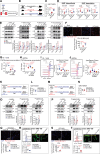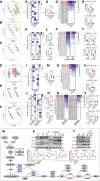Glycolysis-Mediated Activation of v-ATPase by Nicotinamide Mononucleotide Ameliorates Lipid-Induced Cardiomyopathy by Repressing the CD36-TLR4 Axis
- PMID: 38422177
- PMCID: PMC10906217
- DOI: 10.1161/CIRCRESAHA.123.322910
Glycolysis-Mediated Activation of v-ATPase by Nicotinamide Mononucleotide Ameliorates Lipid-Induced Cardiomyopathy by Repressing the CD36-TLR4 Axis
Abstract
Background: Chronic overconsumption of lipids followed by their excessive accumulation in the heart leads to cardiomyopathy. The cause of lipid-induced cardiomyopathy involves a pivotal role for the proton-pump vacuolar-type H+-ATPase (v-ATPase), which acidifies endosomes, and for lipid-transporter CD36, which is stored in acidified endosomes. During lipid overexposure, an increased influx of lipids into cardiomyocytes is sensed by v-ATPase, which then disassembles, causing endosomal de-acidification and expulsion of stored CD36 from the endosomes toward the sarcolemma. Once at the sarcolemma, CD36 not only increases lipid uptake but also interacts with inflammatory receptor TLR4 (Toll-like receptor 4), together resulting in lipid-induced insulin resistance, inflammation, fibrosis, and cardiac dysfunction. Strategies inducing v-ATPase reassembly, that is, to achieve CD36 reinternalization, may correct these maladaptive alterations. For this, we used NAD+ (nicotinamide adenine dinucleotide)-precursor nicotinamide mononucleotide (NMN), inducing v-ATPase reassembly by stimulating glycolytic enzymes to bind to v-ATPase.
Methods: Rats/mice on cardiomyopathy-inducing high-fat diets were supplemented with NMN and for comparison with a cocktail of lysine/leucine/arginine (mTORC1 [mechanistic target of rapamycin complex 1]-mediated v-ATPase reassembly). We used the following methods: RNA sequencing, mRNA/protein expression analysis, immunofluorescence microscopy, (co)immunoprecipitation/proximity ligation assay (v-ATPase assembly), myocellular uptake of [3H]chloroquine (endosomal pH), and [14C]palmitate, targeted lipidomics, and echocardiography. To confirm the involvement of v-ATPase in the beneficial effects of both supplementations, mTORC1/v-ATPase inhibitors (rapamycin/bafilomycin A1) were administered. Additionally, 2 heart-specific v-ATPase-knockout mouse models (subunits V1G1/V0d2) were subjected to these measurements. Mechanisms were confirmed in pharmacologically/genetically manipulated cardiomyocyte models of lipid overload.
Results: NMN successfully preserved endosomal acidification during myocardial lipid overload by maintaining v-ATPase activity and subsequently prevented CD36-mediated lipid accumulation, CD36-TLR4 interaction toward inflammation, fibrosis, cardiac dysfunction, and whole-body insulin resistance. Lipidomics revealed C18:1-enriched diacylglycerols as lipid class prominently increased by high-fat diet and subsequently reversed/preserved by lysine/leucine/arginine/NMN treatment. Studies with mTORC1/v-ATPase inhibitors and heart-specific v-ATPase-knockout mice further confirmed the pivotal roles of v-ATPase in these beneficial actions.
Conclusion: NMN preserves heart function during lipid overload by preventing v-ATPase disassembly.
Keywords: diabetic cardiomyopathies; endosomes; fibrosis; insulin resistance; lipid metabolism; toll-like receptor 4.
Conflict of interest statement
Figures








Comment in
-
Preventing the Fatty Acid-Transporter CD36 From Taking its Toll on the Heart.Circ Res. 2024 Mar;134(5):526-528. doi: 10.1161/CIRCRESAHA.123.323945. Epub 2024 Feb 29. Circ Res. 2024. PMID: 38422178 No abstract available.
References
-
- Costantino S, Akhmedov A, Melina G, Mohammed SA, Othman A, Ambrosini S, Wijnen WJ, Sada L, Ciavarella GM, Liberale L, et al. . Obesity-induced activation of JunD promotes myocardial lipid accumulation and metabolic cardiomyopathy. Eur Heart J. 2019;40:997–1008. doi: 10.1093/eurheartj/ehy903 - PubMed
-
- Joseph JJ, Deedwania P, Acharya T, Aguilar D, Bhatt DL, Chyun DA, Di Palo KE, Golden SH, Sperling LS; American Heart Association Diabetes Committee of the Council on Lifestyle and Cardiometabolic Health; Council on Arteriosclerosis, Thrombosis and Vascular Biology; Council on Clinical Cardiology; and Council on Hypertension. Comprehensive management of cardiovascular risk factors for adults with type 2 diabetes: a scientific statement from the American Heart Association. Circulation. 2022;145:e722–e759. doi: 10.1161/CIR.0000000000001040 - PubMed
Publication types
MeSH terms
Substances
LinkOut - more resources
Full Text Sources
Medical
Molecular Biology Databases

